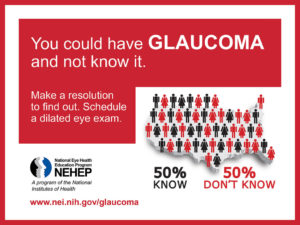Glaucoma Awareness – Early Testing and Detection
 Glaucoma has no symptoms and therefore it is often referred to as the sneak thief of sight. Patients with glaucoma experience no symptoms until the very late stages of the condition. Late stage glaucoma is characterized by profound vision loss.
Glaucoma has no symptoms and therefore it is often referred to as the sneak thief of sight. Patients with glaucoma experience no symptoms until the very late stages of the condition. Late stage glaucoma is characterized by profound vision loss.
Glaucoma Prevention
I am often asked by patients “I have a positive family history. How can I prevent myself from getting glaucoma?” The answer is early detection. We do this by being properly screened during your eye exam.
During your eye exam take advantage of the Comprehensive Digital Retinal Exam technology which allows us to take high-resolution panoramic and ultrasound images of the eye. These technologies combine hundreds of high-resolution images giving us a 3-dimensional view of the optic nerve. Some retinal nerve cells are more sensitive to glaucomatous changes than normal retinal cells. These retinal cells are called ganglion cells and when it comes to glaucoma they are kind of like the canaries in the coal mine. Ganglion cells are usually the first to signal early glaucomatous changes.
Yearly Eye Exams Reduce Blindness
By having yearly eye exams and comparing these digital images over the coming years, we look for subtle changes. Eye doctors usually diagnose glaucoma by noticing these subtle changes in the optic nerve over time.
Learning More
- There are two theories on glaucomatous vision loss, the vascular theory and mechanical theory.
- Some relatively new research also makes a compelling case that glaucomatous changes originate in the brain.
- Take the Glaucoma Eye-Q Test
Early Detection
 If you would like to start the new year off right we would be happy to asses your glaucoma risk factors at your next eye exam. Please call our Colleyville office at or the Keller office at . You can also schedule your appointment online at any time.
If you would like to start the new year off right we would be happy to asses your glaucoma risk factors at your next eye exam. Please call our Colleyville office at or the Keller office at . You can also schedule your appointment online at any time.

 Incorporating the most advanced technology available in caring for our patients is important to the way we practice at Total Eye Care. The Diopsys® Pattern Electroretinograph is the newest addition to our suite of technology. The Pattern ERG (PERG) measures the signal strength of the retinal information being sent to the optic nerve. Studies show that a 10% decrease in this signal can be detected up to 8 years earlier with a Pattern Electroretinograph than a scanning laser ophthalmoscope. This technology thus allows for much earlier diagnosis and treatment.
Incorporating the most advanced technology available in caring for our patients is important to the way we practice at Total Eye Care. The Diopsys® Pattern Electroretinograph is the newest addition to our suite of technology. The Pattern ERG (PERG) measures the signal strength of the retinal information being sent to the optic nerve. Studies show that a 10% decrease in this signal can be detected up to 8 years earlier with a Pattern Electroretinograph than a scanning laser ophthalmoscope. This technology thus allows for much earlier diagnosis and treatment.
 Your eye converts what you see into very low voltage electrical signals that travel along the optic nerve between your eye and the visual cortex. The computer inside the VEP compares the strength and speed of signal to a database of normal results and then the doctor uses that information to guide his or her diagnosis.
Your eye converts what you see into very low voltage electrical signals that travel along the optic nerve between your eye and the visual cortex. The computer inside the VEP compares the strength and speed of signal to a database of normal results and then the doctor uses that information to guide his or her diagnosis. New technology now available at Total Eye Care allows us to scan a patient’s retina for glaucoma and macular degeneration, and the best part ….. it does it WITHOUT DILATION! This new instrument is called the Zeiss Cirrus OCT and it is truly state of the art.
New technology now available at Total Eye Care allows us to scan a patient’s retina for glaucoma and macular degeneration, and the best part ….. it does it WITHOUT DILATION! This new instrument is called the Zeiss Cirrus OCT and it is truly state of the art. Traditional thinking regarding glaucoma is that the either the high pressure slowly crushes the nerve fibers or the pressure decreases blood flow to the optic nerve. Should Dr. Calkins’ findings be confirmed in human studies it would cause a paradigm shift in the treatment and diagnosis of glaucoma. Dr. Calkin’s study demonstrates that glaucoma starts in the brain and then as the disease progresses the optic nerve starts to show evidence of the disease. Currently Dr. Calkins’ research is directed toward looking for medical therapies that can restore the connection of the nerve fibers between the brain and the retina.
Traditional thinking regarding glaucoma is that the either the high pressure slowly crushes the nerve fibers or the pressure decreases blood flow to the optic nerve. Should Dr. Calkins’ findings be confirmed in human studies it would cause a paradigm shift in the treatment and diagnosis of glaucoma. Dr. Calkin’s study demonstrates that glaucoma starts in the brain and then as the disease progresses the optic nerve starts to show evidence of the disease. Currently Dr. Calkins’ research is directed toward looking for medical therapies that can restore the connection of the nerve fibers between the brain and the retina.
 It seems that virtually everyone that has experienced a migraine wants to crawl into a dark room. The February 2010 issue of the journal Nature Neuroscience has published a study that explains why this phenomena may occur.
It seems that virtually everyone that has experienced a migraine wants to crawl into a dark room. The February 2010 issue of the journal Nature Neuroscience has published a study that explains why this phenomena may occur.

